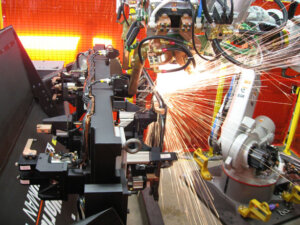When welding is done by hand, there are many subtle adjustments that a skilled welder can make to compensate for any variations in the stick electrode. (Kudos to those of you who immediately recognized this image from Flashdance. And kudos to the 80s for encouraging the dual skill set of welding and dancing. Let’s bring that back.)
Alternatively, when using robots for resistance spot welding that can’t compensate for variation in the electrode, it must remain precisely in place, regardless of a changing position. Sounds like a minor matter, especially when compared to the intelligent travel path required of the robot, but the consequences of a misaligned electrode can include weak, imperfect, or improperly placed welds.
Electrodes are rapidly and forcefully heated, pressed, and cooled. It’s no easy job, and yet the electrode must remain in position throughout its life cycle. The resistance welding process typically requires two electrodes that transmit heat and compressive force to either side of the workpiece. And the key is to create a perfect contact patch on both sides. This not only provides the optimal pressure, but generates the engineered conduction between the electrode and welded materials.
Over time, certain electrode materials can slowly disintegrate, compromising their shape and the contact patch. They can deform due to poor material selection, causing similar misalignment and deflections. As a result, material properties are a fundamental consideration when selecting a resistance welding electrode. For example, tungsten and molybdenum display excellent hardness even when heated, and are often selected for high current and short shot cycles.
In addition, industry best practices dictate providing for a margin of error. In essence, the electrode is made slightly larger than the contact patch, so any contact misalignment can be accommodated. Waste weld heat is dissipated, which also enables the electrode to operate at a lower average temperature. This can reduce electrode tip sticking and lengthen electrode life.
To learn more about additional best practices as well as material and design considerations for maximizing the life and effectiveness of your resistance welding electrodes, download our guide to Resistance Welding Electrode Materials: Selecting the Right One for Your Application.






